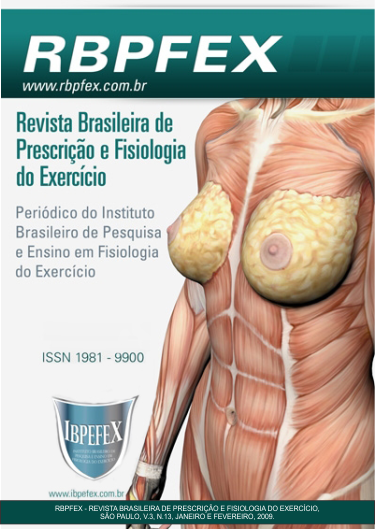Effects of personalized circuit training in two group of women whit ages on from 23 to 49 on their anthropometry and body composition during 12 weeks
Abstract
The purpose of the study is to analyze and compare the effects a one hoer individualized circuit training, two to three time a week, managed by a personal coach, on the anthropometry and composition of 14 sedentary women, divided in two group of 7 with two e three practice weeks, whit the average and standard variations: age 34.28±10.22 to 40.14±8.25 age, stature 164.14±4.33 to 163.28±2.81cm, e corporal mass 59.06±4.36 a 65.48±9.55 Kg. The training sessions had twin places at the subjects homes in Curitiba-PR. The result that had significant variations were: age, stature, % fat, mass is bone mass, between pré and pós-test of the 2 group more muscle-mass was developed on the with 3 training sessions a week. Comparing the variable values, acquired on the pós-test, no relevant variation was noticed on the subject of both group. In conclusion, only comparing pre and pós-test of the two groups, significant variations could be observed. No evidences show better result training 2 times a week than tree times a week as expected. Future studies whit control of the variables that have limited this research are required so, the results are true and applicable only for the subjects observed on the study and must not be generalized.
References
- American Diabetes Association. Physical Activity/Exercise and Diabetes Melli-tus. Diabetes Care, v.26, Supplement 1. January 2003
- ACSM. Position Stand on the Appropriate Intervention Strategies for Weight Loss and Prevention of Weight Regain for Adults. Med. Sci. Sports Exerc. v. 33, nº12. 2001, pp. 2145–2156.
- Bompa, T.O. A periodização no treinamento esportivo. Barueri-SP. Manole, 2001.
- Després, J.P.; Pouliot, M.C.; e colaboradores. Loss of abdominal fat and metabolic response to exercise training in obese women. American Journal of Physiology. V. 261. nº 24. pg E159-E167, 1991.
- Guedes, D.P., Guedes, J.E.R.P. Controle do Peso Corporal: Composição Corporal Atividade Física e Nutrição. Londrina PR. Midiograf, 1998.
- Heyward, V.; Stolarczyk, J.H. Avaliação da Composição corporal Aplicada. São Paulo: Manole, 2000.
- Janet, P.W. Exercise in Hypertension: A Clinical Review. Clinical Exercise Physi-ology Laboratory, Department of Kinesiology, Indiana University, Bloomington, Indiana, USA. Sports Méd. 2003; 33 (8): 585-598.
- Jesus, G.M.; Souza, C.L. Um estudo sobre o emagrecimento: da teoria à experimentação com um grupo de funcionarias da Universidade Estadual de Feira de Santana. 2001.
- McArdle, W.D.; Katch, F. I.; Katch, V.L. Fisiologia do Exercício: Energia, Nutrição e Desempenho Humano. 5a ed. Rio de Janeiro RJ. Guanabara, 2003.
- Pitanga, F.J.G. Atividade Física e Perfil de Distribuição da Gordura Corporal. Revista Brasileira Atividade Física & Saúde. v. 3 nº3. p. 67-75. Salvador BA. Setembro de 1998.
- Petroski, E.L. Desenvolvimento e validação de equações generalizadas para a estimativa da densidade corporal em adultos. Tese de doutorado. UFSM, 1995.
- Pollock, M.L.; Willmore, J.H. Exercícios na saúde e na doença: avaliação e prescrição para prevenção e reabilitação. 2º ed. Rio de Janeiro: Medsi, 1993.
- Rocha, M.L. Peso ósseo do brasileiro de ambos os sexos de 17 a 25 anos. Arquivos de anatomia e antropologia, v. 1, p. 445-451, 1975.
- Siri, W.E. Body composition from fluid space and density. In J. Brozek & Hanschel, A. (Eds.) Techniques for measuring body composition. Washington, DC, Na-tional Academy of Science.
- U.S. Department of Health and Human Services. Physical Activity and Health: A Report of the Surgeon General. Atlanta, GA: U.S. Department of Health and Human Services, Centers for Disease Control and Prevention, National Center for Chronic Dis-ease Prevention and Health Promotion, 1996.
- Wurth, A. La femme et le sport. Medicne Sportive, v. 4, n. 1, 1974.
Authors who publish in this journal agree to the following terms:
- Authors retain the copyright and grant the journal the right of first publication, with work simultaneously licensed under the Creative Commons Attribution License BY-NC which allows the sharing of the work with acknowledgment of the authorship of the work and initial publication in this journal.
- Authors are authorized to enter into additional contracts separately for non-exclusive distribution of the version of the work published in this journal (eg, publishing in institutional repository or book chapter), with acknowledgment of authorship and initial publication in this journal.
- Authors are allowed and encouraged to post and distribute their work online (eg, in institutional repositories or on their personal page) at any point before or during the editorial process, as this can bring about productive change as well as increase impact and impact. citation of published work (See The Effect of Free Access).






